Adrian Collins's Blog, page 161
September 22, 2021
The Music of The Band by Nicholas Eames
If you haven’t had a chance to check out Nicholas Eames’s series The Band, you should stop what you are doing and go read that right now because The Band is seriously next level.
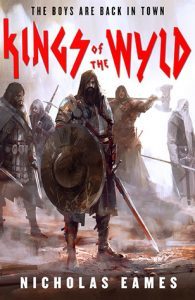 Kings of the Wyld, the first book of The Band combines the frenetic swagger and energy of David Lee Roth on stage owning the crowd mixed in with the “take no shit” of AC/DC. But instead of music this band creates madness and brings pain upon their foes. I kid you not, I was humming Back in Black through most of my reading of Kings of the Wyld. It was obvious to me as a reader that Eames has a connection with music. From the obvious, he named the series The Band to the less overt in how the fight scenes are orchestrated. Eames mentions below how some of the fight scenes are done in short frenetic bursts like a drummer playing.
Kings of the Wyld, the first book of The Band combines the frenetic swagger and energy of David Lee Roth on stage owning the crowd mixed in with the “take no shit” of AC/DC. But instead of music this band creates madness and brings pain upon their foes. I kid you not, I was humming Back in Black through most of my reading of Kings of the Wyld. It was obvious to me as a reader that Eames has a connection with music. From the obvious, he named the series The Band to the less overt in how the fight scenes are orchestrated. Eames mentions below how some of the fight scenes are done in short frenetic bursts like a drummer playing.
Eames was kind enough to talk with us a bit about his connection with music and the wonderful Spotify playlists that he had created to go along with the first two books in the series, Kings of the Wyld, and Bloody Rose. There is also mention about the upcoming book, Outlaw Empire, which will be the third book in the series. As a fan, I can’t tell you how excited I will be to jump into that book when it comes out, and also take a deep dive into that playlist. “Nirvana, Nas, Pearl Jam, NWA, and a whole lotta Rage Against the Machine” are the bands that had a huge influence upon me growing up. A story that has a whole lotta RATM is going to be quite the story indeed. “Killing in the name of…”
Check out Nicholas’s great article below.
Kings of the WyldThe great thing about the rock and folk music of the 1970s (from which Kings of the Wyld draws inspiration) is that many of the songs are long, rambling epics that are well suited to listening to while writing. I always had a playlist going while writing the first book of The Band. Sometimes it was something new—an artist or album I’d never heard before—and sometimes it was music that suited the “vibe” of a particular scene. Often these songs would go on repeat for however many hours it took me to finish the chapter.
An example of this is when Matrick (whose character represents the “drummer” of the band) fights by himself against overwhelming odds. While writing this scene I played Led Zeppelin’s Moby Dick over and over. The song features a lengthy drum solo by John Bonham, which, when performed live, often went on for more than fifteen minutes. While describing the fight, I used terms like “parsing out violence in short, frenetic bursts” that evoked the idea of a drummer playing for all he was worth.
In another chapter, where the band is fleeing a raging dragon on board an airship, I was seriously stuck when it came to writing the action sequence. Thankfully, the entire scene suddenly came to me while listening to ZZ-Top’s La Grange on my walk to work. You could probably read the last half of that chapter aloud and find it aligns perfectly with the highs and lows of the song itself.
When it came time to write an epic climax, there was only ever one song I had in mind—arguably the greatest song in the long history of humankind: Freebird, by Lynyrd Skynyrd. For months and months I’d been listening to it while walking pretty much anywhere, imagining how the events of the final battle would unfold. Of all the scenes I dream of seeing on film or TV someday (fingers crossed), the Battle of the Bands is chief among them.
Bloody RoseI took a different tack with Bloody Rose, since screaming hair metal and wailing love ballads aren’t great music for writing to—for me, at least. The music of the 80s (like the band in the book itself) demands your attention, so when it came time to work I put on synthwave instead, which has an epic 80s feel without being a distraction.
In the previous book, each of the main characters was representative of a corresponding band member, but in Bloody Rose the characters are instead representative of distinct musical genres. Rose is the glam rock, Brune the metal, Cura the goth (she’s named for The Cure, after all), and Freecloud the pop. Tam, meanwhile, is a mixed bag of Journey songs and Stevie Nicks. There are references to each throughout the book, such as Tam’s age (the edge of seventeen) and the fact that she takes a “midnight train” in the early chapters of the book. If that reference goes over your head, it’s likely you’ve never screamed the lyrics to Journey’s Don’t Stop Believing at the top of your lungs, and I am truly sorry for that.
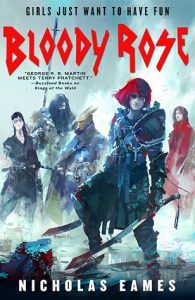 There’s a song Tam sings on several occasions called Together. It was her mother’s most famous ballad—a love-letter to her bandmates that is known by pretty much every mercenary in the world. This song, which features in what I hope is a fairly poignant scene near the end of the book, was inspired by a very specific live version of U2’s One, wherein Bono lets the crowd sing most of the song. When writing that scene, I tried to capture the same skin-tingling feeling I get whenever I listen to that song. Having just re-read that scene…I’d say I nailed it.
There’s a song Tam sings on several occasions called Together. It was her mother’s most famous ballad—a love-letter to her bandmates that is known by pretty much every mercenary in the world. This song, which features in what I hope is a fairly poignant scene near the end of the book, was inspired by a very specific live version of U2’s One, wherein Bono lets the crowd sing most of the song. When writing that scene, I tried to capture the same skin-tingling feeling I get whenever I listen to that song. Having just re-read that scene…I’d say I nailed it.
The climax of Bloody Rose was written while listening to the song For Crying Out Loud by Meatloaf. I’d heard the song before, but I didn’t give it a fair shake until I was writing the final battle and someone on Twitter mentioned what a great song it was. From that point on, I listened to it about five or six times on my way to work (and again on my way home), imagining how the scene would play out. Like the “dragon chase” in Kings of the Wyld, what ended up on the page syncs very closely to the song when read aloud. There’s a reference to it in the text as well: “She didn’t scream, though her soul would be crying out loud.” It’s not one I’d expect anyone to catch unless they were looking for it, but it makes me happy to know it’s there.
Outlaw EmpireLike Bloody Rose before it, Outlaw Empire is the story of a new generation and draws inspiration from the music of the 1990s—chiefly grunge and hip-hop. Expect to find artists like Nirvana, Nas, Pearl Jam, NWA, and a whole lotta Rage Against the Machine on the playlist. And while I can’t divulge too much about the plot, I will say that many of these bands share some common traits with the characters of Outlaw Empire: they have no respect for authority and are very pissed off.
The post The Music of The Band by Nicholas Eames appeared first on Grimdark Magazine.
September 21, 2021
REVIEW: Fallen Angels by Anna Mocikat
Behind Blue Eyes was a fascinating book by Anna Mocikat that followed the adventures of a cybernetically enhanced super-soldier named Nephilim. Working for a corrupt and evil corporation that ruled most of America, Nephilim regained her free will and started to explore her humanity before discovering that much of her newfound life was deliberately engineered as a way to entrap her. It was a sexy, dark, and entertaining novel that reminded me a bit of what you’d get if you combined Ghost in the Shell with 1984.
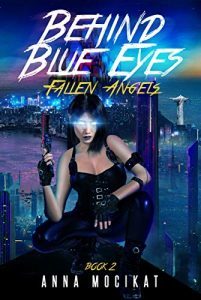 Following up to a book like that is a challenge and I should note one that is inherently full of spoilers when discussing the sequels. If you have any interest in cyberpunk and/or indie science fiction then I suggest you stop reading this review and check it out. If you don’t mind spoilers or are still unsold then by all means continue as it’s still a series worth checking out even if you are familiar with roughly where it’s going.
Following up to a book like that is a challenge and I should note one that is inherently full of spoilers when discussing the sequels. If you have any interest in cyberpunk and/or indie science fiction then I suggest you stop reading this review and check it out. If you don’t mind spoilers or are still unsold then by all means continue as it’s still a series worth checking out even if you are familiar with roughly where it’s going.
Fallen Angels is the second book in the series that follows up on the events of the first one. Nephilim has been forced back into the role of the loyal subordinate to the mysterious Metatron and is carrying out her duties. Being brainwashed into being Metatron’s lover as well as second-in-command, Metatron has no reason to question her existence or her master’s plans to undermine the board of directors for the Olympias corporation.
Unfortunately, for Metatron and Nephilim, someone has discovered a weakness in the Guardian Angels cyborgs. Metatron’s transhumanist plans to overthrow the board and create a society with cyborgs on top depends on their perception as invincible superior beings. That takes a hit when someone starts polishing them off one by one. If an ordinary (?) serial killer can kill superhumans then the latter don’t come off as very super at all.
While the previous book established that there were three remaining megacorporations (Olympias included), we didn’t get any insight into the other ones or how people lived. That is changed here as we find ourselves exploring the methods of control each of them use to dominate the populace. Nephilim’s Eastern European boytoy, for example, lives in a society that is closest to our own but constantly bombarded with propaganda that beings like her are inhuman killing machines like Terminators rather than actual people.
Fallen Angels also introduces some ordinary citizens of Olympias with police officers Shiro and Spider. I really liked these two characters and their perspective on life in the arcologies when you weren’t an amnesiac figure with the powers of Wolverine and Neo. I actually liked Shiro more than Nephilim’s love interest from the previous books and hopes she gets with him. I also appreciated making the board believably scummy, being the kind of venal old rich guys that we have in the real world versus anything supervillainous. It makes you almost want to root for Metatron in overthrowing them despite how much of a monster he is.
Fallen Angels is a great follow-up to Behind Blue Eyes and makes me eager to see what the third book will be like. Nephilim remains a fantastic protagonist despite her “reset” and the deeper insights into the world are very welcome. I also feel like the new characters add a humanistic element that would otherwise be missing until Nephilim gets her free will back. The fact it is a Kindle Unlimited book also means it’s well worth the cost.
Read Fallen Angels by Anna Mocikat
The post REVIEW: Fallen Angels by Anna Mocikat appeared first on Grimdark Magazine.
September 20, 2021
REVIEW: Civilisations by Laurent Binet
Civilisations may rise and fall ,but Civilisations was written by Laurent Binet, translated from the French by Sam Taylor and published in Great Britain by Harvill Secker in 2021. A work entitled with such boldness demands a grand subject matter, and Binet provides this. It is the story of the invasion of Early Modern Europe by the Incas.
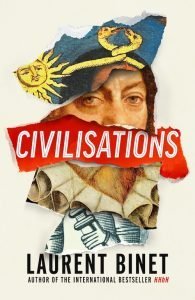 Binet came to view with the 2010 novel HHhH, a history of the Nazi leader Reinhard Heydrich and his assassination, filmed in 2017 as The Man with the Iron Heart. This was followed by The Seventh Function of Language, an Umberto Eco-esque thriller set in the world of late twentieth century Continental Philosophy with the unusual feature of actually including Umberto Eco as a character (as well as Francois Mitterrand, Michel Foucault, and others). Thus with Civilisations Binet has gone from real world events, to the secret history behind real world events – to counterfactual history. Presumably the next step is high fantasy.
Binet came to view with the 2010 novel HHhH, a history of the Nazi leader Reinhard Heydrich and his assassination, filmed in 2017 as The Man with the Iron Heart. This was followed by The Seventh Function of Language, an Umberto Eco-esque thriller set in the world of late twentieth century Continental Philosophy with the unusual feature of actually including Umberto Eco as a character (as well as Francois Mitterrand, Michel Foucault, and others). Thus with Civilisations Binet has gone from real world events, to the secret history behind real world events – to counterfactual history. Presumably the next step is high fantasy.
However, you may be asking how the Incas came to be in Europe in the sixteenth century, and if alien space bats were involved. They were not; Binet posits a migration of norsemen down south from Leif Eriksson’s settlement of Vinland let by a daughter of Erik the Red. This exposes Central and South America to the European germ pool that much earlier, as well as leaving some other cultural traces within Caribbean and Incan civilisation. So, when European exploration finally reaches the Americas, it meets with a heavier form of resistance – and a turning of the tables. An Incan prince, Atahualpa, defeated in civil war uses these ocean-going vessels to return to Western Europe – and, by a combination of luck and judgement deliberately reminiscent of the conquistadors, to come to power.
This is more than enough ground to cover in a trilogy, let alone one book. Binet has taken the approach, however, having the entire book consist of in-universe documents – a Saga, the diary of a European explorer (you’ll know his name, but I won’t spoil it), the Chronicles of Atahualpa (incorporating a number of poems and letters) and a picaresque narrative. The Chronicles form the vast bulk of the novel.
The advantage of this is that Civilisations never feels egregious: if Incan governance is described in slightly too glowing terms, then this is explained by the authors. If the description of Henry VIII is rather cliched, then this is because that English monarch is outside the chronicler’s experience or interest. Each section is written in an appropriate style: the matter-of-fact tone of the Saga, the introspection and desperation of the diary, the sweeping actions and statements of the Chronicle. Binet is to be praised for his deftness in writing these and Taylor in bringing it across through his translation.
Of course, the nature of a chronicle being what it is, any sense of the interior life of the characters is brought across at a remove. Dialogue is rare. Motivation is often either implied or outright stated rather than shown. It’s a little more brisk than an actual chronicle, but this still isn’t exactly a novel. There’s a certain archness to some parts of the narrative as well which the format doesn’t quite flatten out. The occasional piece of sly humour may strike you as rather glib (A pyramid? In the courtyard of the Louvre? Unthinkable.)
None of this, however, makes Civilisations uninteresting. The wonder and terror of an interrupted Renaissance and survival in a new world are engaging subjects well explored. It deserves at least four stars.
Read Civilisations by Laurent Binet
The post REVIEW: Civilisations by Laurent Binet appeared first on Grimdark Magazine.
September 19, 2021
REVIEW: The Escapement by Lavie Tidhar
Lavie Tidhar’s The Escapement is the story of a father’s hopelessness as his son lies dying in a hospital. The story shifts back and forth between his real world agony and the darkly fantastic land known as the Escapement. There he takes on the role of the Stranger, a gunslinger seeking the healing flower Ur-Shanabi. The Escapement takes us to a surreal wild west landscape peopled with mythical beings, stone colossi, demonic shadow beings, and of course… clowns? As the Stranger pursues his quest for the flower, he befriends the card playing Kid, crosses paths with members of the Major Arcana of the tarot and becomes drawn into the war known as the Titanomachy.
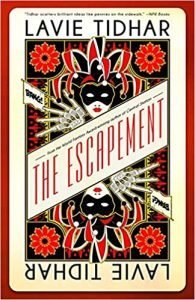 The Escapement is a quick read at about 250 pages, and had a YA feel. The prose is direct and generally simple, which isn’t necessarily a bad thing. This would be a good book for a long flight or to kill time in waiting rooms. There’s not much in The Escapement to make you stop and think, and there’s not much need to return to previous sections to enhance the meaning or understanding of what you’ve just read. Again, this isn’t necessarily a bad thing, it’s just that The Escapement doesn’t have a great deal going on below the surface of what’s printed on the page.
The Escapement is a quick read at about 250 pages, and had a YA feel. The prose is direct and generally simple, which isn’t necessarily a bad thing. This would be a good book for a long flight or to kill time in waiting rooms. There’s not much in The Escapement to make you stop and think, and there’s not much need to return to previous sections to enhance the meaning or understanding of what you’ve just read. Again, this isn’t necessarily a bad thing, it’s just that The Escapement doesn’t have a great deal going on below the surface of what’s printed on the page.
The most interesting feature of The Escapement is the world itself. Tidhar does a good job of creating a surreal world that feels as though it exists on its own, instead of simply being a backdrop for the story of the Stranger. The Titanomachy, for example, feels like an ongoing thread in this world that began long before the Stranger’s journey, and will continue long after. At the same time though, some of the surreal aspects of The Escapement fall flat. In this wild west world, clowns play the role of native Americans. While this does tie in to the world of the father and son, Tidhar does little with it aside from one very memorable section involving a cameo by John Wayne Gacy as Pogo.
The Escapement puts itself into a no man’s land of references and allusions. It seemed as though Tidhar couldn’t decide whether to make allusions or direct references, and instead tried to do both. For example, I felt very clever when I picked up on his reference to Gacy as Pogo. But Tidhar stole my thunder when the Stranger called him by name. Tidhar even goes so far as to list all his references and allusions in his Afterward, as if afraid the reader might have missed something. I felt a little beaten about the head by that.
The Escapement isn’t a bad book. I finished it, and I’m not someone to make myself finish a book I dislike. As I mentioned, it’s a short and easy read. While I wouldn’t try to talk someone out of reading it, I wouldn’t either suggest it to someone. I would read further stories set in this world because the potential is there, The Escapement just didn’t quite get there.
Read The Escapement by Lavie Tidhar
The post REVIEW: The Escapement by Lavie Tidhar appeared first on Grimdark Magazine.
September 18, 2021
REVIEW: Game of Thrones S2
Game of Thrones S2 continues the intriguing, bloody epic telling of George RR Martin’s hugely popular A Song of Ice and Fire. With the honourable Ned Stark’s death allowing the Lannisters to tighten their vice-like grip on the iron throne and the Starks in the north vying for revenge, Westeros braces itself for a war that threatens to tear the land apart.
 Game of Thrones S2 is everything fans of Martin’s novels would have wanted. Based on the second novel in the series (A Clash of Kings), it builds on the excellent foundation set in the first season and though there are even more characters adding to the already long list of names to remember, the efficient writing handles the growing cast with a deft hand that guides the audience and allows each new character to display their personality in brief but important scenes that open the second season. The ten episodes of Game of Thrones S2 never feel bloated while each of the important characters are given time to display their purpose and needs for the season. Robb Stark grows with every episode as he bears the weight of responsibility for seeking revenge for the death of his father. The hideous, immature King Joffrey somehow becomes more despicable with each episode as he threatens to slaughter any who argue against him and he attempts to rule on his own terms and not those of his ambitious mother, the brilliantly devious Cersei Lannister. The excellent writing explores the politics of Martin’s novels with ease and with an outstanding cast, Game of Thrones S2 stands with The Sopranos and The Wire as examples of HBO crafting series that are simply unmissable.
Game of Thrones S2 is everything fans of Martin’s novels would have wanted. Based on the second novel in the series (A Clash of Kings), it builds on the excellent foundation set in the first season and though there are even more characters adding to the already long list of names to remember, the efficient writing handles the growing cast with a deft hand that guides the audience and allows each new character to display their personality in brief but important scenes that open the second season. The ten episodes of Game of Thrones S2 never feel bloated while each of the important characters are given time to display their purpose and needs for the season. Robb Stark grows with every episode as he bears the weight of responsibility for seeking revenge for the death of his father. The hideous, immature King Joffrey somehow becomes more despicable with each episode as he threatens to slaughter any who argue against him and he attempts to rule on his own terms and not those of his ambitious mother, the brilliantly devious Cersei Lannister. The excellent writing explores the politics of Martin’s novels with ease and with an outstanding cast, Game of Thrones S2 stands with The Sopranos and The Wire as examples of HBO crafting series that are simply unmissable.
Peter Dinklage is the standout performer in what must be one of the best casts in a single show in recent memory. He shines as the cunning and sympathetic imp, Tyrion Lannister. Unwanted and despised by his ambitious and powerful family, he finds himself in Ned Stark’s vacated role as Hand of the King. Watching Tyrion in his battle of wits as he trades barbs with the always smirking Petyr Baelish, the clever eunuch Varys, or his hateful sister Cersei is always a joy. Dinklage was justly nominated for an Emmy for the way he plays the Tyrion with such complexity and proves that he can hang with any character in the series. He provides Game of Thrones S2 much of its humour as he attempts his best to keep the tyrannical Joffrey from abusing his power and turning the common people of King’s Landing against his family. He provides a voice of reason as the rest of the Lannister drown with in their need for power. “You did nothing when your son called for Ned Stark’s head. That little bit of theatre will haunt our family for a generation…”
Game of Thrones S2 is nothing short of brilliant. Any worries that it would be unable to live up to the high expectations set by the first season have been burned away by wildfire. An outstanding cast, strong writing, and the penultimate episode, Blackwater (written by George RR Martin himself), will go down as one of the best battles ever witnessed on the small screen. An incredible season that sets the standard for not just for fantasy, but for all TV shows. Huge, epic battles, sharp writing, and a badass baby dragon, if you haven’t watched Game of Thrones S2 yet, what are you waiting for?
The post REVIEW: Game of Thrones S2 appeared first on Grimdark Magazine.
September 17, 2021
REVIEW: Behind Blue Eyes by Anna Mocikat
Behind Blue Eyes by Anna Mocikat is the first book of the same series. It is an independently published book and was mentioned in our recent recommendations of indie cyberpunk listicle. While some people believe cyberpunk hit its heyday during the Eighties, the folk here at Grimdark Magazine believe that its themes of unchecked looter capitalism, environmental collapse, and government technological abuse are more relevant than ever. I think this is an excellent example of these themes as well as a solid action novel.
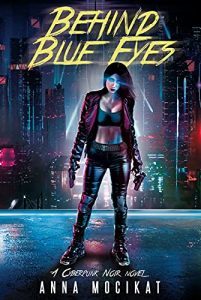 The premise is that the future is dominated by massive arcologies run by megacorporations. This is a classic idea but one that I never get tired of. Olympias City is one of those arcologies and it is protected by an army of super-powerful cybernetic soldiers called Guardian Angels. They are taken as children and indoctrinated along with upgraded until all of them are unquestioning weapons for the state.
The premise is that the future is dominated by massive arcologies run by megacorporations. This is a classic idea but one that I never get tired of. Olympias City is one of those arcologies and it is protected by an army of super-powerful cybernetic soldiers called Guardian Angels. They are taken as children and indoctrinated along with upgraded until all of them are unquestioning weapons for the state.
Nephilim is one of the rising stars of the Guardian Angels and the favorite of High Archangel Metatron. Growing up in the materialist society of Olympias City, she is blind to the majority of the state’s flaws and irony in her name choice. However, when damaged during a mission, she finds herself freed from the “Grid” and regaining a measure of free will. She uses this time to explore the reality she’s lived in with a fresh set of (glowing blue) eyes and seeing what she’s missed.
Anna Mocikat seems to have been inspired by a combination of 1984, Ghost in the Shell, and The Matrix. There’s a lot of literary references to George Orwell, though her dystopia is more a seeming promiscuous utopian with a horrifying underbelly ala Brave New World than the overt failure of Oceania. I really liked how transhumanism is something that has been turned into another weapon for society’s elite as it costs so much to improve humanity than only a minority receive enhancements while the others view them as terrifying monsters.
Much of the story is taken up by Nephilim’s growing friendship with two men in her life: Finnwick and Jake. The former is a nerdy, almost comically so, individual who helps her become free of the system while the latter is her dashing love interest. Neither of them are quite what they seem and the twists involved in their stories are a major source of tension. There is also the figure of Metatron, the mysterious leader of the Guardian Angels, who seems to be both Nephilim’s ally and enemy until his true allegiances become apparent.
The book has a lot of really great action scenes and I think would translate well to cinema. The Guardian Angels are super-fast, strong, and durable faced against armies of squishy humans. The fact our heroine is also surrounded by equally powerful and dangerous killing machines that could find out her secret at any point is a major source of the book’s tension. I also appreciate the heroine is biracial since that’s still rare in the genre.
Behind Blue Eyes is a solid book and available for 99c right now as well as being on Kindle Unlimited for those who don’t want to spend too much money. It’s certainly worth it and I immediately picked up the sequel after finishing it. It definitely scratched my cyberpunk itch and I think it will do the same for you. Plus, it’s always good to support indie authors.
Read Behind Blue Eyes by Anna Mocikat
The post REVIEW: Behind Blue Eyes by Anna Mocikat appeared first on Grimdark Magazine.
September 16, 2021
REVIEW: Half a War by Joe Abercrombie
Half a War is the concluding instalment of Joe Abercrombie’s epic Shattered Sea trilogy. It is a satisfying conclusion to the saga but it is hard to say how without spoiling some of the plot! Suffice to say almost all the questions Abercrombie has posed get answered and many loose threads tied off but I still feel like there is scope in this world for more.
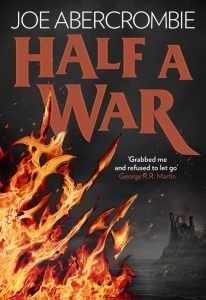 As with the first two books Yarvi is a pivotal character. In Half a War Yarvi remains the Minister to the King of Gettland and unsurprisingly he is the architect of the new, rather shaky alliance with their former foe of Vansterland, and their joint war against Grandmother Wexen and the High King she serves. We do not have as much of Yarvi in this novel but his presence is still felt throughout. I feel that in this book more than the others Yarvi has become a true grimdark protagonist. Perhaps that is because the character has aged a little, as well as a culmination of the prior events in the series but he is so deliciously grey in Half a War. Yarvi is not a hero and although he is incredibly cunning and clever, Half a War shows his mental flaws in a never before seen way.
As with the first two books Yarvi is a pivotal character. In Half a War Yarvi remains the Minister to the King of Gettland and unsurprisingly he is the architect of the new, rather shaky alliance with their former foe of Vansterland, and their joint war against Grandmother Wexen and the High King she serves. We do not have as much of Yarvi in this novel but his presence is still felt throughout. I feel that in this book more than the others Yarvi has become a true grimdark protagonist. Perhaps that is because the character has aged a little, as well as a culmination of the prior events in the series but he is so deliciously grey in Half a War. Yarvi is not a hero and although he is incredibly cunning and clever, Half a War shows his mental flaws in a never before seen way.
Abercrombie continues to have an ensemble of main characters and new narrative perspectives in Half a War as he did in Half the World. Yarvi, Thorn Bathu and Brand are still key players in this instalment but they share the page with three new faces. The first of these is the Princess Skara of Throvenland, a war refugee seeking sanctuary and an alliance with Gettland and Vansterland so that she can reclaim her lands and throne which have been annexed by the High King. Skara has lost almost everything but has a mind that could match Yarvi so it is very interesting to watch her storyline unfurl. Though I will admit that this is one of the few times in the series that I felt a character was a trope, a defenceless maiden in need of saving from the cruel world. However I feel this initial presentation and subsequent character development was absolutely intentional from Abercrombie. Indeed I would not be surprised if Abercrombie chose to carry on Skara’s story if he were to return to the world of the Shattered Sea.
The next new character perspective we have is Raith, a sworn sword to the King of Vansterland. Like Thorn, Raith is described as being ‘touched by Mother War’ so he is another warrior perspective and offers an almost total contrast to the third point of view character, Koll.
Koll was a minor character in the previous book, but in Half a War he plays a greater role as Father Yarvi’s apprentice. There is an even balance to the ensemble between the born fighters, peacemakers, and masterminds but it at times feel convoluted. I liked the switch of perspectives in Half the World, Thorn and Brand were engaging and I cared for them even if I did not always like them. It was almost too much to have these three new key characters in the final novel of the trilogy and expect to form the same bond with them without going in to more depth than Abercrombie does. I think that is why they sometimes feel superficial and gives an inconsistent pace compared to the earlier novels.
However, that does not make Half a War predictable. As the title suggests, we only see the war from one side, so the vicious schemes of Grandmother Wexen, the battles, their gains and losses pack a strong punch. There are other twists and turns that blindsided me and have left me wanting to know so much more about the history of the Shattered Sea. This is the first time in the series that I found it frustrating that there has not been the same detailed world building here as there is in other grimdark realms. In Half a War Abercrombie has mostly the same fast pace as he did in the previous two novels in the series which make it a tense and engaging. It is a tumultuous journey and there are enough bloody battles, betrayals, and bombshell revelations that it is an enjoyable read to most fantasy fans. I like Half a War for the part it plays in the trilogy but I do not think it could be read as a standalone novel in the same way Half a King or Half the World could, it definitely needs the support and preamble its predecessors afford it to be appreciated.
Read Half a War by Joe Abercrombie
The post REVIEW: Half a War by Joe Abercrombie appeared first on Grimdark Magazine.
REVIEW: Angels of Death: Awakenings
We continue our episode-by-episode coverage of Warhammer TV’s Angels of Death with episode 4, Awakenings. And from the outset, during a flashback, where Kazarion speaks of the Black Rage with the mighty Lord Mephiston (the only Blood Angel to conquer the black rage in over 10,000 years, if memory serves), we pretty much know what’s coming. And Blood Angels fans will be absolutely frothing for it!
In the hive city the Blood Angels continue to push deeper into the infrastructure to find captain Orpheo. They discover further signs of him and forge on, but the big cracks in their brotherhood really start to show here—and we really get into the character driven part of the story, which I’m starting to really warm up to.
Interestingly, Awakenings puts us in with the Tyranid horde’s leader, who beseeches the Many-Armed God (AKA, the colossal hive mind in control of the horde not just on this planet, but in entire sections of the galaxy) to help his horde destroy the Blood Angels. We get a glimpse of their grand plan and an insight into what the big bad are trying to achieve—something which in true brilliant 40k fashion is so, so much larger than just the taking of one Captain Orpheo.
And just like that, the Blood Angels are surrounded, and a desperate battle commences. The movement and action is pretty solid once more. But honestly, the guns and grenades just seem to get forgotten really quickly—perhaps it’s just too hard to animate enough of a horde flowing to offset the damage bolt rounds on full auto are supposed to do. Overall, the battle is great fun to watch, though.
Here we are also introduced to a new aspect of impending danger, the Black Rage. For fans new to 40k or the Blood Angels, the Black Rage is, in short, a sliver of berserk manic darkness every Blood Angel carries inside that turns them into berserk murderers. It grows and grows, until, at some point, it takes over and the man is lost to the blood thirst. When this happens, the Chapter will paint their armour black, point them in the direction of an unassailable adversary, and let them go out in a blaze of glory. Every Blood Angel must control it for as long as possible, and our protagonist, Kazarion, has to deal with it alone, away from his brothers, and we see big shades of his struggle with it in this fight. Is he about to lose control?
The end of Awakenings is a deadset cliffhanger and I am so keen for next Wednesday to roll around!
Read our previous episode reviews, here.
Watch Angels of Death: Awakenings on Warhammer TVThe post REVIEW: Angels of Death: Awakenings appeared first on Grimdark Magazine.
September 15, 2021
REVIEW: A Ritual of Bone by Lee C. Conley
A little bit fantasy, a little bit horror, A Ritual Bone was a whole lot of awesome. Lee C. Conley crafted an excellent fantasy that is liberally sprinkled with viscera, although never at the cost of story.
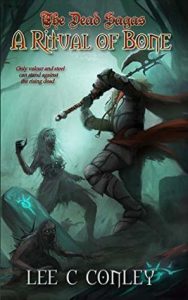 I have not read a ton of Norse inspired fantasy, although I am getting a bit more experience with that kind of setting. However, I am pretty sure that zombies don’t usually make an appearance in this sort of book, and I was here for it!
I have not read a ton of Norse inspired fantasy, although I am getting a bit more experience with that kind of setting. However, I am pretty sure that zombies don’t usually make an appearance in this sort of book, and I was here for it!
At its heart, A Ritual of Bone was about the people and how they deal with an unexpected disaster of the sort that you can’t ever be prepared for, even if you have prepared. Seeing the lengths the characters went to and what their motivations were was truly fascinating.
There were several things throughout this book that were done incredibly well. First, there’s the use of magic to make an unutterably stupid mistake, one with disastrous consequences. Curiosity killed the…well, in this case it killed more than just the cat. I will never stop loving the idea of someone dabbling in things they really shouldn’t. It is absolutely believable and can lead a plot in so many unexpected directions.
Another way that A Ritual of Bone killed it is with the zombies themselves. They weren’t the mumbling, shuffling (and-frankly- boring) kind of undead. Rather, they felt a little like a starving wild animal: desperate, cornered, and vicious. They were often nail-bitingly intimidating. I also liked that they didn’t jump straight into mindless killer mode. There were moments of introspection, even, from the zombies themselves. This was not done in a comical way, and it served to add an extra level to an already emotionally charged book.
The book was never scary, but it happily lurked in that stressful territory that will always keep me reading late into the night. I was fully invested from very early on. The atmosphere in A Ritual of Bone was brilliant. Conley was a wizard in his descriptions, casting a smokey pall that was gritty, dark, and extremely compelling.
The book followed multiple characters, all of which offered something different to the plot. While they were all well-written, there were a couple who stood out to me. Bjorn, a hunter who was captured by wild men, was quite possibly my favorite. I also really liked reading about Nym, whose purpose was to take care of her brother, which provided a different perspective.
A Ritual of Bone did come across as a little repetitive from time to time, but it was not enough to dull my enjoyment in any way. It is a small niggle in an otherwise great book. There are some questions I hope to see answered in the future, and I’m excited to continue on to book two.
I recommend A Ritual of Bone to readers who want a new take on zombies, or readers who like a sense of urgency in their fantasy.
Read A Ritual of Bone by Lee C. Conley
The post REVIEW: A Ritual of Bone by Lee C. Conley appeared first on Grimdark Magazine.
September 14, 2021
Discussing the Wisdom of Crowds with Joe Abercrombie
With The Wisdom of Crowds being released this week, Gollancz gave me the opportunity to interview Joe Abercrombie about the influences for The Age of Madness and Bayaz, the risks of putting new characters into a world fans already love, and what the author can’t wait to see in this epic age of televised SFF.
[GdM] The Age of Madness has strong themes of rebellion and instability. How much of an impact did current world events across your home in the UK and the US influence the writing of this latest trilogy?
 Well . . . certainly some, I guess. Everyone who writes fantasy (and everyone who reads it) are people living in the real world, so I don’t think you can escape, or would particularly want to escape, being influenced by everything that’s going on around you, and your opinions and attitudes naturally find their way out in what you write.
Well . . . certainly some, I guess. Everyone who writes fantasy (and everyone who reads it) are people living in the real world, so I don’t think you can escape, or would particularly want to escape, being influenced by everything that’s going on around you, and your opinions and attitudes naturally find their way out in what you write.
That said, I started writing this trilogy way back in 2015 and the decision to set it during the early stages of an industrial revolution, then a social revolution, went back a fair bit further than that. So a certain amount of social turmoil was baked into the concept and that was part of the appeal for me – there’s a lot of conflict and drama inherent in the period and the setting – rich against poor, tradition against innovation, monarchy against democracy. That we seem to have entered our own little political and cultural age of madness in the UK and US since I started writing it was to some degree coincidental. I think the political mood certainly had an impact. But at the same time I found I’d written about a few things – riots, corruption, statue toppling – that then became major issues in the news and the writing became almost a little too on the nose. So if anything real events gave me an opportunity to reconsider and refine some of what I’d written, rather than inspiring me to do it in the first place.
[GdM] When writing The Age of Madness, did you see advancing the age of the setting and the generation of characters as a risk? What made you want to take that leap?
I guess every book feels like a bit of a risk to some extent – you’re always wondering whether readers will like new characters and new approaches – and there are definitely some fantasy readers who are very attached to their medieval worlds and start to get a bit uncomfortable as things turn more modern, even if the mindsets of many of the characters in classic fantasy are very modern. But I don’t think you can worry too much over what any imagined group of readers might think – apart from anything else it’s almost impossible to anticipate what people actually will end up liking or objecting to – so you’ve really got to write to your own taste if you’re going to produce anything worthwhile. And I don’t want to write in a world that feels static or to endlessly come back to the same characters. You have to move things forward, keep things fresh, keep yourself interested and challenged. A reader might spend a week or two with a book and be keen for more. A writer spends years with it, and more often than not is ready to move on afterwards.
[GdM] What were the periods and places in history you drew your influence from for this trilogy?
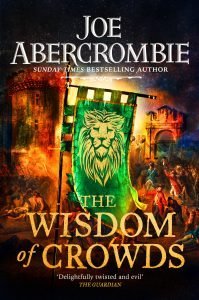 Chiefly the early industrial revolution in the UK and Europe, so during the period of water-power, as the steam engine is starting to appear, and society is being recast at break-neck pace by innovations not just in the technical realm but the financial and social ones. But then later by the French and Russian revolutions, as you will probably see more than ever in the Wisdom of Crowds…
Chiefly the early industrial revolution in the UK and Europe, so during the period of water-power, as the steam engine is starting to appear, and society is being recast at break-neck pace by innovations not just in the technical realm but the financial and social ones. But then later by the French and Russian revolutions, as you will probably see more than ever in the Wisdom of Crowds…
[GdM] How does it feel to have—and how difficult is it to write—your characters aging? And, not to be too cheeky, but when I met you in Sydney you were actually a bit of a unit, so how much of the aches and pains are based on lived experience?
Well I’ve often said Glokta grew partly out of the experience of being laid up for a couple of weeks with a bad back, so most things are to some degree drawn out of lived experience – albeit exaggerated, overstated, refined to an intense point. I actually enjoy the characters aging and changing and making way for a new generation. It’s all part of a world that’s constantly developing. The brash young turks of the past become the parents and great statesmen of the present (if they survive), and the the myths and cautionary tales of the future.
[GdM] Bayaz is one of the most believable villains in contemporary dark fantasy: introduced as a wise father figure, he is revealed to be a power-hungry manipulator of the worst kind. What influences inspired this character and his ongoing role in your novels?
Mostly Gandalf. Though also Merlin and Belgarath and host of other irrascible but goodly wizardly mentors throughout fantasy. Bayaz is their dark reflection, I guess. In the edition of Lord of the Rings I read (often) as a kid, there was a foreword by Tolkien where he answered the question of whether the book was an allegory for the world wars by saying, if it had been, Gandalf would have used the ring. And I thought right then that would make a very interesting variation. In a world without absolute good, without an unchallengeable divine mission, Gandalf very quickly becomes quite a terrifying figure – a near-immortal, enigmatic manipulator without doubt or scruple when it comes to achieving his ends, plus a combination of huge power and a short fuse. He’s already a pretty terrifying figure if you’re an orc, after all…
[GdM] As a huge fan of short stories, Sharp Ends is one of my favourite books ever. Do you have plans for any further short works to help fill out the backstories of your characters?
There actually already are three that were written to go in some special editions of the three Age of Madness books, and I’ve written a fourth more considerable one – they’re going to be bound together into an illustrated novella by Subterranean Press in September 2022. It’s called The Great Change, and other Lies.
[GdM] Why the fuck aren’t we watching season 3 of a First Law TV series by now?
Ha. Well that is a long tale that shall be told at some time, I daresay, but probably not today…
[GdM] On your blog you mentioned you’re a mere 35K words into a new project. Are you able to give us any detail about the setting, story, or characters in the new book you’re writing?
I think I’m about 100k in now but still less than half way through, so I really failed to stick to my planned word count yet again with this one. It’s both familiar in some ways and a radical departure in others. It features a group of mismatched extremely messed-up heroes/villains on a morally ambiguous quest. But it takes place in a slightly ridiculous version of our own world packed with magic, monsters, and shoddy research.
[GdM] You’ve previously spoken about being really into text-based adventures as a kid. Has this lockdown given you an opportunity to get into some old-school text-based gaming with your family or some of your friends online (eg. through a MMORPG)?
I certainly did lose many hours on text-based adventures as a kid, but then that’s what there was at the time. The world has since given us Total War, so I can instead spend thousands of hours playing that.
[GdM] What are the three bits of SFF in any medium that you’re looking forward to most?
Interesting question – I must admit that I don’t consume very much fantasy in written form, I tend to find it too close to what I do, and it’s difficult to turn off the analytic side of my brain and lose myself in it like I did before I was a writer. On the TV side, what I’ve seen of Foundation looks pretty spectacular, and far enough from the books that whether or not they have much in common starts to be a bit of a moot point, plus I’m a big fan of Jared Harris. I am curious to see what the Lord of the Rings TV show ends up like, given the colossal amount of money spent on it, and my long-standing love of Middle Earth, though I really worry when they make anything like that from such limited source material – their chances of really capturing Tolkien’s tone AND making something that works for a modern audience seem slim, but I live in hope. On the gaming side, I’ve always loved Dark Souls so what I’ve seen of Elden Ring has me very excited.
Read The Wisdom of Crowds by Joe Abercrombie
The post Discussing the Wisdom of Crowds with Joe Abercrombie appeared first on Grimdark Magazine.




